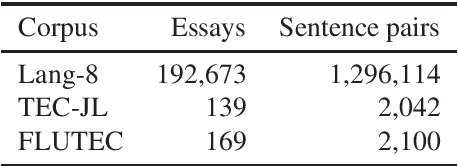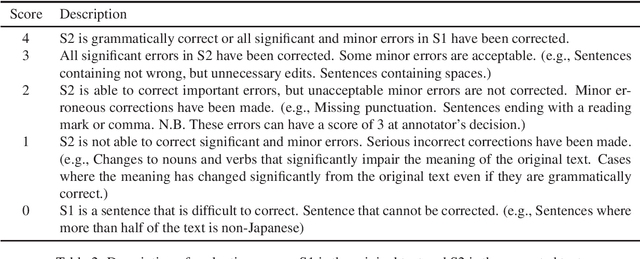Tosho Hirasawa
SBS Figures: Pre-training Figure QA from Stage-by-Stage Synthesized Images
Dec 23, 2024



Abstract:Building a large-scale figure QA dataset requires a considerable amount of work, from gathering and selecting figures to extracting attributes like text, numbers, and colors, and generating QAs. Although recent developments in LLMs have led to efforts to synthesize figures, most of these focus primarily on QA generation. Additionally, creating figures directly using LLMs often encounters issues such as code errors, similar-looking figures, and repetitive content in figures. To address this issue, we present SBSFigures (Stage-by-Stage Synthetic Figures), a dataset for pre-training figure QA. Our proposed pipeline enables the creation of chart figures with complete annotations of the visualized data and dense QA annotations without any manual annotation process. Our stage-by-stage pipeline makes it possible to create diverse topic and appearance figures efficiently while minimizing code errors. Our SBSFigures demonstrate a strong pre-training effect, making it possible to achieve efficient training with a limited amount of real-world chart data starting from our pre-trained weights.
Pruning Multilingual Large Language Models for Multilingual Inference
Sep 25, 2024Abstract:Multilingual large language models (MLLMs), trained on multilingual balanced data, demonstrate better zero-shot learning performance in non-English languages compared to large language models trained on English-dominant data. However, the disparity in performance between English and non-English languages remains a challenge yet to be fully addressed. A distinctive characteristic of MLLMs is their high-quality translation capabilities, indicating an acquired proficiency in aligning between languages. This study explores how to enhance the zero-shot performance of MLLMs in non-English languages by leveraging their alignment capability between English and non-English languages. To achieve this, we first analyze the behavior of MLLMs when performing translation and reveal that there are large magnitude features that play a critical role in the translation process. Inspired by these findings, we retain the weights associated with operations involving the large magnitude features and prune other weights to force MLLMs to rely on these features for tasks beyond translation. We empirically demonstrate that this pruning strategy can enhance the MLLMs' performance in non-English language.
COM Kitchens: An Unedited Overhead-view Video Dataset as a Vision-Language Benchmark
Aug 05, 2024Abstract:Procedural video understanding is gaining attention in the vision and language community. Deep learning-based video analysis requires extensive data. Consequently, existing works often use web videos as training resources, making it challenging to query instructional contents from raw video observations. To address this issue, we propose a new dataset, COM Kitchens. The dataset consists of unedited overhead-view videos captured by smartphones, in which participants performed food preparation based on given recipes. Fixed-viewpoint video datasets often lack environmental diversity due to high camera setup costs. We used modern wide-angle smartphone lenses to cover cooking counters from sink to cooktop in an overhead view, capturing activity without in-person assistance. With this setup, we collected a diverse dataset by distributing smartphones to participants. With this dataset, we propose the novel video-to-text retrieval task Online Recipe Retrieval (OnRR) and new video captioning domain Dense Video Captioning on unedited Overhead-View videos (DVC-OV). Our experiments verified the capabilities and limitations of current web-video-based SOTA methods in handling these tasks.
Construction of a Quality Estimation Dataset for Automatic Evaluation of Japanese Grammatical Error Correction
Jan 20, 2022



Abstract:In grammatical error correction (GEC), automatic evaluation is an important factor for research and development of GEC systems. Previous studies on automatic evaluation have demonstrated that quality estimation models built from datasets with manual evaluation can achieve high performance in automatic evaluation of English GEC without using reference sentences.. However, quality estimation models have not yet been studied in Japanese, because there are no datasets for constructing quality estimation models. Therefore, in this study, we created a quality estimation dataset with manual evaluation to build an automatic evaluation model for Japanese GEC. Moreover, we conducted a meta-evaluation to verify the dataset's usefulness in building the Japanese quality estimation model.
Keyframe Segmentation and Positional Encoding for Video-guided Machine Translation Challenge 2020
Jun 23, 2020

Abstract:Video-guided machine translation as one of multimodal neural machine translation tasks targeting on generating high-quality text translation by tangibly engaging both video and text. In this work, we presented our video-guided machine translation system in approaching the Video-guided Machine Translation Challenge 2020. This system employs keyframe-based video feature extractions along with the video feature positional encoding. In the evaluation phase, our system scored 36.60 corpus-level BLEU-4 and achieved the 1st place on the Video-guided Machine Translation Challenge 2020.
Towards Multimodal Simultaneous Neural Machine Translation
Apr 07, 2020



Abstract:Simultaneous translation involves translating a sentence before the speaker's utterance is completed in order to realize real-time understanding in multiple languages. This task is significantly harder than the general full sentence translation because of the shortage of input information during decoding. To alleviate this shortage, we propose multimodal simultaneous neural machine translation (MSNMT) which leverages visual information as an additional modality. Although the usefulness of images as an additional modality is moderate for full sentence translation, we verified, for the first time, its importance for simultaneous translation. Our experiments with the Multi30k dataset showed that MSNMT in a simultaneous setting significantly outperforms its text-only counterpart in situations where 5 or fewer input tokens are needed to begin translation. We then verified the importance of visual information during decoding by (a) performing an adversarial evaluation of MSNMT where we studied how models behave with incongruent input modality and (b) analyzing the image attention.
Debiasing Word Embeddings Improves Multimodal Machine Translation
May 28, 2019



Abstract:In recent years, pretrained word embeddings have proved useful for multimodal neural machine translation (NMT) models to address the shortage of available datasets. However, the integration of pretrained word embeddings has not yet been explored extensively. Further, pretrained word embeddings in high dimensional spaces have been reported to suffer from the hubness problem. Although some debiasing techniques have been proposed to address this problem for other natural language processing tasks, they have seldom been studied for multimodal NMT models. In this study, we examine various kinds of word embeddings and introduce two debiasing techniques for three multimodal NMT models and two language pairs -- English-German translation and English-French translation. With our optimal settings, the overall performance of multimodal models was improved by up to +1.93 BLEU and +2.02 METEOR for English-German translation and +1.73 BLEU and +0.95 METEOR for English-French translation.
Multimodal Machine Translation with Embedding Prediction
Apr 01, 2019



Abstract:Multimodal machine translation is an attractive application of neural machine translation (NMT). It helps computers to deeply understand visual objects and their relations with natural languages. However, multimodal NMT systems suffer from a shortage of available training data, resulting in poor performance for translating rare words. In NMT, pretrained word embeddings have been shown to improve NMT of low-resource domains, and a search-based approach is proposed to address the rare word problem. In this study, we effectively combine these two approaches in the context of multimodal NMT and explore how we can take full advantage of pretrained word embeddings to better translate rare words. We report overall performance improvements of 1.24 METEOR and 2.49 BLEU and achieve an improvement of 7.67 F-score for rare word translation.
 Add to Chrome
Add to Chrome Add to Firefox
Add to Firefox Add to Edge
Add to Edge